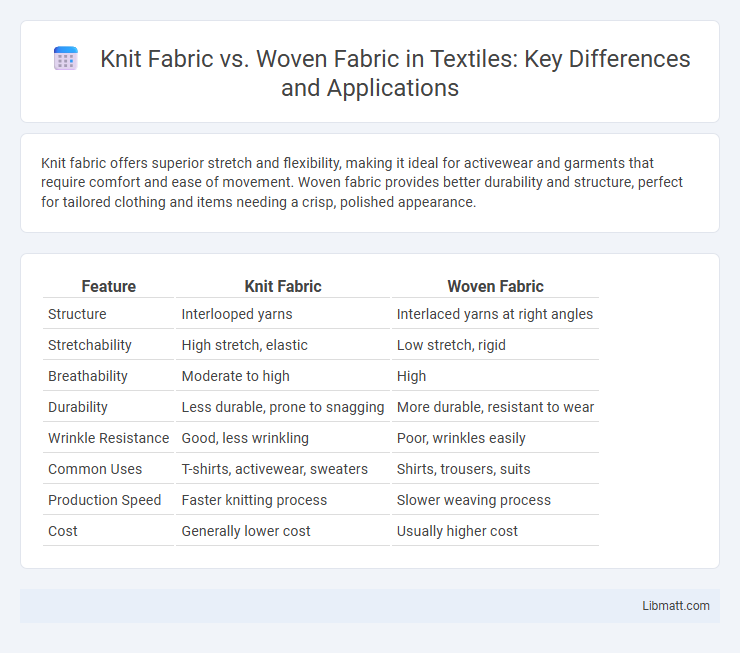Knit fabric offers superior stretch and flexibility, making it ideal for activewear and garments that require comfort and ease of movement. Woven fabric provides better durability and structure, perfect for tailored clothing and items needing a crisp, polished appearance.
Table of Comparison
| Feature | Knit Fabric | Woven Fabric |
|---|---|---|
| Structure | Interlooped yarns | Interlaced yarns at right angles |
| Stretchability | High stretch, elastic | Low stretch, rigid |
| Breathability | Moderate to high | High |
| Durability | Less durable, prone to snagging | More durable, resistant to wear |
| Wrinkle Resistance | Good, less wrinkling | Poor, wrinkles easily |
| Common Uses | T-shirts, activewear, sweaters | Shirts, trousers, suits |
| Production Speed | Faster knitting process | Slower weaving process |
| Cost | Generally lower cost | Usually higher cost |
Introduction to Knit and Woven Fabrics
Knit fabric is created by interlocking loops of yarn, resulting in a stretchy, flexible material ideal for activewear and casual clothing. Woven fabric consists of yarns woven tightly at right angles to each other, producing a durable and structured textile commonly used for shirts, pants, and upholstery. Understanding the differences between knit and woven fabric helps you choose the best material for comfort, durability, and garment function.
Understanding Knit Fabric Construction
Knit fabric construction involves interlocking loops of yarn, creating a flexible and stretchable material ideal for garments requiring comfort and movement, such as t-shirts and activewear. This looped structure allows knit fabrics to retain shape and resist wrinkles more effectively than tightly bonded woven fabrics. Understanding knit fabric construction highlights its advantages in durability, elasticity, and breathability compared to the interlaced yarns of woven fabric.
What Defines Woven Fabric?
Woven fabric is defined by its interlacing structure, where two sets of yarns--the warp and the weft--are woven at right angles to create a stable and durable textile. This method results in fabrics known for their strength, minimal stretch, and crisp texture, making them ideal for tailored garments and home furnishings. Your choice of woven fabric impacts garment fit and resistance to wear, as the tight weave affects flexibility and breathability.
Key Differences Between Knit and Woven Fabrics
Knit fabric is constructed by interlocking loops of yarn, offering greater stretch, flexibility, and comfort, making it ideal for activewear and casual clothing. Woven fabric, created by interlacing two sets of yarns at right angles, provides durability, structure, and resistance to distortion, commonly used in formal wear and upholstery. Your choice depends on the desired fabric properties such as stretchability, strength, and texture for specific garment applications.
Durability Comparison: Knit vs Woven
Woven fabric generally offers superior durability due to its interlaced thread structure, making it resistant to wear and tear, ideal for heavy-use garments. Knit fabric, characterized by looped yarns, provides greater stretch and flexibility but tends to be less durable under constant friction or rough conditions. Your choice should balance the need for durability with comfort, as woven fabrics excel in longevity while knits prioritize softness and elasticity.
Comfort and Feel: Which Fabric Wins?
Knit fabric offers superior comfort and flexibility due to its looped construction, allowing for greater stretch and breathability that adapts to your movements. Woven fabric, with its tight interlacing threads, provides durability but tends to be less flexible and breathable, often feeling stiffer against the skin. For everyday wear prioritizing softness and ease, knit fabric typically wins in comfort and feel.
Applications in Fashion and Apparel
Knit fabric offers superior stretch and flexibility, making it ideal for activewear, casual wear, and form-fitting garments, enhancing comfort and movement. Woven fabric provides durability and structure, commonly used in tailored clothing such as suits, dress shirts, and outerwear, delivering a polished and crisp appearance. Your choice between these fabrics depends on the desired balance of comfort, fit, and garment function within fashion and apparel design.
Maintenance and Care Guidelines
Knit fabrics require gentle washing with cold water and mild detergents to maintain elasticity and prevent shrinkage, while avoiding bleach and high heat drying is essential. Woven fabrics often tolerate higher washing temperatures and can be ironed at moderate heat to remove wrinkles, but dry cleaning may be recommended for delicate weaves. Proper storage for both fabric types includes keeping them in a cool, dry place to prevent mildew and fabric degradation.
Sustainability Considerations
Knit fabric generally offers greater sustainability due to its production efficiency, using less material and generating less waste compared to woven fabric. The elasticity of knit fabric enhances garment lifespan by providing better fit and comfort, reducing the need for frequent replacement. Your sustainable fashion choices can benefit from selecting knit fabrics, which often require less energy and water during manufacturing.
Choosing the Right Fabric for Your Needs
Knit fabric offers superior stretch and comfort, making it ideal for activewear and casual clothing, while woven fabric provides durability and structure, perfect for formal wear and upholstery. Consider the intended use, as knit fabrics allow flexibility and breathability, whereas woven fabrics deliver strength and shape retention. Your choice should balance comfort, appearance, and durability based on the fabric's unique properties.
Knit fabric vs Woven fabric Infographic

 libmatt.com
libmatt.com